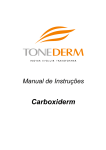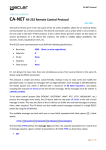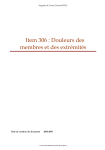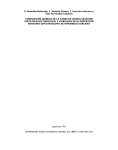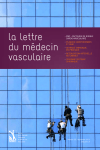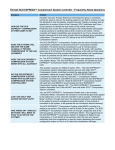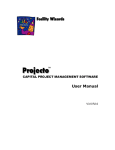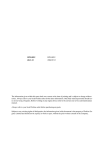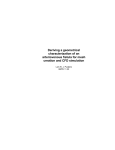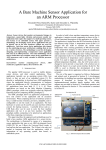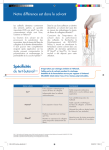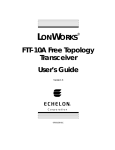Download ArtAssist - deprimo.ie
Transcript
ArtAssist ® … the Arterial Assist Device™ Model AA-1000 Operations and Service Manual 1857 Diamond Street • San Marcos, California 92078 • USA Telephone: (760) 744-4400 • Toll Free: (888) 4 LEG FLO Fax: (760) 744-4401 • E-mail: [email protected] www.artassist.com L 5.14 Rev. 006, Effective Date: April 20, 2007 0 L 5.14 Rev. 006, Effective Date: April 20, 2007 AD2-00201 and above TABLE OF CONTENTS OPERATIONS MANUAL Introduction………………………………...…………………………….……………..…3 How To Get Started………………..………………….…………………………………..4 Indications/ Contraindications ……………………………..………………………....…..5 Safety Considerations……………………………………..……………………….……...6 Labels……………………………...………………………………………...……….….7,8 Physical Description………………………………….………………………….……9,10 Internal Pressure Adjustment & Patient Compliance Assessment……………………....11 Maintenance……………………………………………………………………………...12 Patient’s Instructions For Use………………………………………………………...13,14 Packing Instructions…………………….………………………………………………..15 References……………………………………………………………………………16-20 European Authorized Representative……………………………………………………21 SERVICE MANUAL Pneumatic Circuit…………………….…………..………………….…………….……..23 Pressure and Timing Profile……………………..……………………………………….24 Pressure Adjustment……………………………………………………………………..25 Tank Flushing Instructions………………………………………………………………26 Troubleshooting …………………………...…………………………………………27-29 APPENDIX Electrical Schematics………………………………………………………….Appendix A L 5.14 Rev. 006, Effective Date: April 20, 2007 1 OPERATIONS MANUAL L 5.14 Rev. 006, Effective Date: April 20, 2007 2 INTRODUCTION When you finish reading this operations and service manual, you will become an ArtAssist Model AA-1000 expert! Well, maybe not an expert, but our hope at ACI Medical, LLC. is to provide you with an informative manual to answer any questions you might have regarding this device. This manual is filled with important information, useful tips and enlightening pictures to help you. GENERAL DESCRIPTION The ArtAssist device is the only external pneumatic compression device developed with vascular surgeons for the sole purpose of increasing blood circulation and specifically, arterial blood flow. It applies impulse pressure to the foot, ankle, and calf. Singlepatient-use cuffs are made of soft durable material designed to last for months of therapy. Therapy takes place with the patient in a comfortable sitting position. The patient only needs to turn the device on since all pressure and timing controls are pre-set and hidden from the patient. It is portable and suitable for home, clinic or hospital use. This device significantly increases patients’ blood flow in the popliteal artery and at the tissue level.1,3,5,6,11 Improvements were observed in calf blood flow using duplex ultrasonic imaging and APG Air-Plethysmography.2 Further, it has been shown that calf and foot region compression increases volumetric blood flow by better than three times that of foot-only compression as measured by duplex ultrasonography.3 Venous return flows are increased over 5 times in muscular, superficial and deep veins.12 ArtAssist® has saved limbs in severe cases where amputations below the knee were expected.4,10 ArtAssist® is composed of three basic components: an electrically operated controller, tubing sets that conduct the air pulses from the controller to the cuffs and single patient use limb cuffs. The controller is connected to a wall outlet for power using the included power cord. Either one or two pneumatic limb cuffs can be attached to the controller via pneumatic fittings. The cuffs are for use on either left or right limbs and are “one size fits all.” The only control available to the user of the controller is an ON-OFF power switch that illuminates when power is applied. Pressure and time parameters have been optimized for the population of ischemic patients; but in rare cases, the applied pressure may be altered by opening the front panel. In three separate studies, this device was shown to significantly improve pain free walking distance in patients with intermittent claudication and that those improvements were long-lasting after therapy was discontinued. L 5.14 Rev. 006, Effective Date: April 20, 2007 3 HOW TO GET STARTED 1. Unpack items and SAVE ALL PACKING MATERIALS AND PAPERWORK. You will need this to return the device to ACI. 2. Place controller by a chair for use in therapy. 3. Plug power cord into a wall outlet and the opposite end into controller, located on the lower side. 4. Plug the tubing set with the black plastic connector at the end into the upper side of the controller. Plug all the way in. 5. Connect the other end of the tubing set into the compression cuff. Plug barb fittings labeled “To Foot Cuff” into the foot cuff and “To Calf Cuff” into the calf cuff. 6. Keep any wound healing bandages in place and apply a white athletic sock on the feet to be treated. 7. Wrap compression cuffs around foot, ankle, and calf as shown on pictorial instruction card or on the Instructional VHS/DVD. 8. Sit with feet on the floor and then turn on power switch on the controller to begin therapy. 9. After 1-hour therapy, the controller will stop compressing and “TIMED OUT” will appear on the controller near the power switch. Removed cuff(s) and store until the next therapy session. 10. Typically therapy consists of 1-hour compression, 3 times a day (morning, afternoon and evening). Your doctor may prescribe a different usage for you. L 5.14 Rev. 006, Effective Date: April 20, 2007 4 INDICATIONS This device is adjunct therapy for patients with ischemic disease of the lower limbs. It is indicated for patients with poor circulation including: * REST PAIN, NIGHT PAIN * ULCERS * INTERMITTENT CLAUDICATION * ISCHEMIA * SMALL VESSEL DISEASE * GRAFT FAILURE * ARTERIOPATHIC WOUNDS * ANGIOPLASTY/STENT FAILURE * MINOR AMPUTATIONS CONTRAINDICATIONS 1. Infected limbs 2. Limbs with suspected deep vein thrombosis or arterial clots 3. During episodes of inflammatory phlebitis or pulmonary embolism 4. When increased venous and lymphatic return is undesirable (such as congestive heart failure) Precaution: For use only under medical supervision. This device is restricted to sale by or on the order of a physician. L 5.14 Rev. 006, Effective Date: April 20, 2007 5 SAFETY CONSIDERATIONS SAFETY FEATURES: • The device is safety fused for: 1. Excessive current consumption by the controller 2. Excessive current consumption by only the internal pump • Alarms will sound if there are any problems concerned with overpressure, under pressure, air leaks, power supplies, and pump temperature. • A cooling fan is installed for temperature stability. • In an alarm condition, power is removed from the pump and solenoid valves, which exhausts pressure from all cuffs. The cooling fan remains on. • If the unit loses power, all cuffs exhaust. SAFETY WARNINGS: • Compression cuffs must be removed before walking or the patient MAY SLIP AND FALL. • Apply the cuffs over bandages and clean white cotton socks. • ArtAssist is to be used by the patient only. It is not to be used for any other person, nor for any other purpose than as prescribed by the Physician. • The patient should contact their Physician if they notice a change of skin condition at or near the sites of the cuff, such as any rash, redness, blister, etc. The patient should examine the site before and after use. • Proper use of the device is to be monitored by the patient and Physician, and not by ACI. • ELECTRICAL HAZARD: Do not operate in wet areas or with wet hands, feet, etc. • Avoid spilling any liquids onto the control units. This can cause possible damage to the unit. • After therapy, be sure to put it in a safe place and out of reach of children. • If rented, return the device and accessories to ACI promptly after Physician orders discontinuation of its use. • Stop use if alarm sounds and refer to Trouble Shooting section. • There is no known potential electromagnetic or other inference between the ArtAssist® device and other devices. L 5.14 Rev. 006, Effective Date: April 20, 2007 6 LABELS On Top Of Controller ArtAssist®…the Arterial Assist Device TM Produced under license by Dr. Paul S. van Bemmelen. ACI Medical, LLC. 90-2492-001 On Bottom Of Controller DANGER Risk of electric shock. Disconnect power cord before opening or servicing this device. WARNINGS 1. 2. Only qualified service personnel should repair this device. Improper repair may result in serious injury, death, equipment damage or malfunction. For continued protection against fire and shock hazards, replace internal fuses only with same type and rating (GMA 1.0 Amp). 90-2491-001 L 5.14 Rev. 006, Effective Date: April 20, 2007 7 On Side Of Controller Abbreviated Instructions 1. 2. 3. 4. 5. 6. 7. Refer to the instruction manual for further details. Apply compression cuff to affected limb over all bandages and clean socks. Do not allow compression cuff to contact broken, irritated or ulcerated skin. Attach the cuff’s hoses to appropriate connectors and into the control unit. Observe labels for “foot” and “calf” for proper attachments. Sit in a comfortable chair with legs resting in a downward position or on the floor. Apply power with the POWER switch located on the front panel. The switch will illuminate to show the device is on. The controller will turn off automatically after one hour. Check for skin condition changes after each use and notify physician of any worsening. Clean this control unit with a damp cloth containing mild disinfectant solutions or detergents and water. Use this device only as prescribed by your doctor. Do not use for any other purpose or on other individuals. Front Panel Lights TIMED OUT will light after the controller has operated for one hour. Turn the power switch to OFF and then back to ON when compression therapy is to resume. REPAIR LEAK will light when the controller cannot operate at the proper pressure. Check the cuffs, tubing and connectors for possible leaks. REPAIR will light when there is something wrong with the controller that can only be repaired by qualified service personnel. Call for service. CAUTIONS 1. 2. 3. Use under medical supervision. Federal law restricts this device to sale by or on the order of a physician. While using oxygen, position this device only at the foot of the bed or as far as possible from equipment administering oxygen. CONTRAINDICATIONS 1. 2. 3. 4. 5. Do not prescribe or use this device: During episodes of inflammatory phlebitis or pulmonary embolism; When deep vein thrombosis is diagnosed or suspected; When increased venous or lymphatic return is undesirable including presumptive evidence of congestive heart failure; On limbs with uncontrolled infection; When pain increases significantly or with worsening skin tissue condition. PRECAUTIONS 1. 2. The doctor is advised to make frequent observations of treated limbs for skin lesions and signs of infection. Use of ArtAssist® with acute arterial thrombi may cause distal embolization. DANGER Risk of explosion. Do not use this device in the presence of flammable anesthetics or other flammable gases. DANGER For grounding reliability, plug only into a three pronged grounded outlet. When used in a health care facility, use only with an outlet labeled “Hospital Grade.” US pat. no. 5,218,954. Israel pat. no. 106,258. RSA pat. No. 93/4841. Other US and foreign pat’s. pending. 90-2493-001 ACI Medical, LLC., San Marcos, CA, USA Tel. 888-4 LEG FLO L 5.14 Rev. 006, Effective Date: April 20, 2007 115V, 60Hz, 0.4A 8 PHYSICAL DESCRIPTION ArtAssist Model AA-1000 Figure 1 1. Controller Specifications (Unilateral or Bilateral* System) Operating Voltage 115 V, 60 Hz 220 V, 50 Hz 100 V, 60 Hz Model Number AA-1000 AA-1000e AA-1000n Max. Current 0.4 Amps 0.2 Amps 0.5 Amps Maximum Operating Temperature: 85º F degrees Power cord – at least 6 feet long, hospital grade plug, universal female Size – 10” wide, 12” high, 7 ¾ deep. The top handle adds 1 ¼” in height. Weight – 23 pounds, controller only Indicators – Located in “black-out” on the front panel’s black bezel just to the right of the power switch. TIMED OUT indicates the device has been continuously in use for about one hour. L 5.14 Rev. 006, Effective Date: April 20, 2007 9 REPAIR LEAK indicates an under pressure condition, most likely due to an air leak somewhere in the system. Check for leaks in the cuffs, tubing and connectors. The pump may be malfunctioning or there may be a leak elsewhere in the system. It takes between 170 and 290 seconds of a leak condition to activate the alarm. REPAIR indicates that there is a problem in the system that is not leak related. Refer to the Trouble Shooting section. Generally, cycling the controller’s power by turning it off then back on will reset the indicators. 2. Tubing sets – Two included in bilateral system. Six feet long, ¼”ID, ½”OD vinyl, dual lumen with keyed, proprietary connector for attaching to the controller and barb fittings to attach to the cuffs. 3. Compressions cuffs – FOR SINGLE PATIENT USE ONLY. Two tubing sets and compression cuffs are included in a bilateral system. 1. Outside surface – Heavy-duty nylon tricot of hook-compatible loop with polymer lamination for air bladder integrity. There are two internal bladders: one for the foot and ankle regions; another for the calf region. 2. Inside surface – Napp nylon tricot cloth with polymer lamination. 4. Instructions – An instructional video (DVD), pictorial instruction sheet and operations and service manual are supplied with all units. Note: Instruction manuals are not included with rental units because the VHS/DVD and pictorial instruction sheet are sufficient for proper operation. Most physicians wish the patient to be unaware of the internal clock that monitors patient compliance. L 5.14 Rev. 006, Effective Date: April 20, 2007 10 INTERNAL PRESSURE ADJUSTMENT AND PATIENT COMPLIANCE ASSESSMENT Pressure Adjustment The ArtAssist® device has undergone clinical testing13 to determine the optimal timing and pressure settings for maximizing the increase of arterial inflow. The timing parameters are therefore not adjustable. However, patients with ischemic rest pain or other conditions may experience discomfort from the factory pre-set pressure of 120 mmHg. When that is the case, the pressure may be reduced by the clinician only, by turning the pressure regulator knob counter clockwise. Compression with a lower pressure may reduce the patient's pain and allow for gradual increase of pressure back to 120 mmHg as the patient is able. Make pressure changes by only using a pressure gauge, provided through ACI. Call 8884 LEG FLO to borrow a pressure gauge at no charge. The front panel is opened by removing the two screws located on the bottom of the controller toward the front. Be sure to disconnect the power cord from the controller before opening the front panel. For instructions to adjust pressure, refer to page 25 in this manual. Timing Settings All timing parameters have been established based upon clinical studies and are preset at the factory. They are changeable only at the factory. Compression Time: 3 seconds, +/- 0.5 seconds. Non-Compression Time: 17 seconds, +/- 3 seconds. DELAY between foot/ankle and calf bladders: 1 second, +/- 0.5 seconds. Pressure Rise and Fall Times: approximately 300 msec, +/- 100 msec. Patient Compliance Assessment The Run time hour meter is located under the front panel toward the left side. It reads out total time the controller is operated and cannot be reset. This is a tamper proof feature. Patient compliance can be easily assessed by subtracting successive meter readings. ACI records the meter reading before the device is shipped. This reading is available to clinicians by calling ACI. Please provide the serial number, patient name or prescribing doctor's name. Close the panel using the screws to prevent further access. L 5.14 Rev. 006, Effective Date: April 20, 2007 11 MAINTENANCE The device requires little maintenance, but it is recommended that hospitals maintain the unit as required by hospital safety regulations. For home use, ACI recommends the cleaning of the exterior case and tubing with a damped cloth of mild soap and water or alcohol between different patient’s use. Suggested Cleaning Procedure for Hospital Use 1. Clean the device between different patient’s use or after 1-month by the same patient. 2. Wipe all areas of the device using a cloth and an EPA registered hospital-grade disinfectant following the manufacturer’s Material Safety Data Sheet. It is recommended that hospital gloves be used to prevent the possible spread of infections. 3. Clean all visible soiling. 4. If blood or body fluids are present on the device, follow the 2 step cleaning process recommended by OSHA. a) Apply an EPA registered tuberculocidal disinfectant. visible soil. Remove and clean all b) Wipe down with 1:100 sodium hypochlorite solution. 5. Remove gloves and wash hands thoroughly. 6. Allow the device to dry before reusing. The pressure delivered to the cuffs should be checked at least annually by connecting a calibrated pressure gauge (available from ACI) to any one of the controller’s pneumatic outlet connectors. Pressure accuracy of ± 10mmHg is adequate according to the most recent clinical studies, which are available from ACI upon request at no charge. Check for overpressure alarm operation by increasing the regulator’s output to 170mmHg ± 10mmHg with the pressure gauge attached. Alarm should activate after one second. Check for improper deflation alarm operation by temporarily plugging the outlets of the 6mmHg relief valves. Alarm should activate after 10 seconds. Check the connectors and tubing sets at least annually for integrity and proper sealing and for possible kinking of the hoses. Also, inspect the power cord for damage and replace as necessary. Clean the fan filter annually or every 8000 hours, whichever is sooner. L 5.14 Rev. 006, Effective Date: April 20, 2007 12 PATIENT’S INSTRUCTIONS FOR USE Review the VHS/DVD and pictorial instructions that came with the device. If unavailable, follow the steps below. STEP 1 • Set the controller by a chair for use in therapy. Plug the electrical cord into the controller and the wall outlet, with power switch in the off position. Be careful not to obstruct the air inlet, which is located on the side of the controller near the power cord inlet. Plug the other end of the power cord into a properly grounded AC wall outlet. Do not use an extension cord or a “cheater” adapter that eliminates the effect of the ground pin on the outlet plug. In health care facilities, used only AC outlets labeled “Hospital Grade.” • Plug the tubing set’s dual connector into the controller’s pneumatic outlet. Attach the tubing’s barb connectors to the two elbow fittings on the cuffs by observing the FOOT and CALF labels. STEP 2 • Note how the cuff is assembled when it arrives. The foot area is folded to create a sandal. Apply the cuff over a clean white sock with bandages left in place as described and pictured below. FOOT: Place the cuff open on the floor with the Velcro®-like hook tape facing up and the hose fittings facing down (Figure 2). Center your foot over the cuff (Figure 3). Bring the side straps over the top of the foot and attach them snugly with the Velcro®-like hook tape (Figure 4). Bring the back heel strap around the ankle and attach it (Figure 5). CALF: Center the remaining cuff behind your calf. Attach the upper and lower straps snugly around the front of the leg with Velcro®-like hook tape (Figure 6). Plug the barbed hose connector labeled “TO FOOT” into the lower cuff’s hose fitting on the side of the ankle (Figure 7). Plug the barbed hose connector labeled “TO CALF” into the upper cuff’s hose fitting behind the calf or use integral dual connectors. (Figure 8). Figure 2 Figure 3 Figure 4 L 5.14 Rev. 006, Effective Date: April 20, 2007 Figure 5 13 Figure 6 Figure 7 Figure 8 STEP 3 • Sit with feet on the floor and then turn on the power switch on the controller to begin therapy. Turn off the switch to end therapy or wait for the 1-hour “timed out” indicator depending on your prescription. Turn off power to stop the audible and visual indicators. • It is recommended to use this device at least 3-4 hours a day, for 1 hour intervals or as instructed by your doctor. (Ideally: 60 minutes in the morning, 60 minutes in the afternoon, 60 minutes in the evening and 60 minutes before bedtime. For those who work or unable to work around the ideal schedule: 1-2 hours in the morning and 1-2 hours at night may be adequate). Consult your doctor and follow the prescribed schedule. IMPORTANT: Call ACI with any questions before use at (888) 4 LEG FLO. Remove cuffs before walking or YOU MAY SLIP AND FALL. Report any adverse skin changes, pain, infection, or other medical issues to your doctor. This device is for use only on the prescribed patient. It is not to be used on others. ELECTRICAL HAZARD: Do not operate in wet areas or with wet hands, feet, etc. If you experience any problems with ArtAssist® controller, tubing, cuffs, or the electrical cord, please contact your local representative or ACI at (888) 4 LEG FLO. Please refer to the “Rental Agreement And Doctor’s Prescription” that you and your physician signed for additional information. DO NOT MACHINE WASH THE CUFFS. ONLY. WIPE WITH A MOIST CLOTH Velcro® is a registered trademark of Velcro Corp. L 5.14 Rev. 006, Effective Date: April 20, 2007 14 PACKING INSTRUCTIONS Upon termination of your prescription by your doctor, return the device, the power cord, tubing, and the instructional videotape to ACI by using the Federal Express Airbill that was sent with the device. Do not send back the cuffs; they are yours to keep. 1. Carefully pack the controller with its top handle facing up and curved front panel matching the curved part of the front panel to the bottom packing foam. Put the top packaging foam over the top of the controller again, matching the curved part of the front panel to the packing foam. 2. Put the tubing, power cord and videotape into the white accessory box and slide it down into the slots in front of the controller’s front panel (Figure 9). 3. Use the tape enclosed to seal the box, as shown in Figure 10. 4. Place the Federal Express Airbill that was sent with the ArtAssist device on the top of the box, as shown below. 5. Telephone Federal Express at 1-800-GO-FEDEX (1-800-463-3339), then press the * key when connected. TAPE TOP VIEW LOOKING DOWN ARTASSIST® CONTROLLER AIRBILL FOAM PACKING ACCESSORY BOX Figure 9 Figure 10 IMPORTANT: Keep all packing materials and use it to the device, power cord, VHS/DVD, and tubing to ACI. L 5.14 Rev. 006, Effective Date: April 20, 2007 15 REFERENCES 1. Augmentation of Blood Flow in Limbs with Occlusive Arterial Disease by Intermittent Calf Compression. van Bemmelen, P.S.; Mattos, M.A.; Faught, W.E., Mansour, M.A.; Barkmeier, L.D.; Hodgson, K.J.; Ramsey, D.E.; and Sumner, D.S. Springfield, IL. J of Vas Surg 1994; 19:1052-8. 2. Intermittent Pneumatic Compression Therapy in Patients with Leg Ischemia. Banga, J.D.; Idzerda, H.H.D.; Schuurman, J.G.; and Eikelboom, B.C. Vascular Center, Academic Hospital, Utrecht, the Netherlands. 17th World Congress International Union of Angiology, London; April 1995. 3. Intermittent Calf and Foot Compression Increases Lower Extremity Blood Flow. Eze, A.R.; Comerota, A.J.; Cisek, P.L.; Holland, B.S.; Kerr, R.P.; Veeramasuneni, R.; and Comerota, A.J. Jr. Temple University School of Medicine, Philadelphia, PA USA. 24th Annual meeting of the Society for Clinical Vascular Surgery; March 1996. Am J Surg 1996; 172:130135. 4. Acute Effects of Intermittent Pneumatic Foot and Calf Compression on Lower Limb Venous Hemodynamics. Labropoulos, N.; Buckman, J.; Size, G.; and Wightman, R. Vascular Diagnostics, Ltd., Parkridge, IL; Division of Surgery, Loyola Medical Center, Maywood, IL. Society of Vascular Technology 20th Annual Conference, San Francisco, CA; July 1997. 5. Intermittent Foot and Calf Compression: Effects on Arterial Blood Flow and Value in Treatment of Intermittent Claudication. Nicolaides, A.N. and Delis K. 24th Annual Symposium on Current Critical Problems, New Horizons and Techniques in Vascular and Endovascular Surgery; November 1997. 6. Intermittent Pneumatic Foot and Calf Compression: Determining Its Optimal Effect on Venous Haemodynamics Using Direct Pressure Monitoring. Delis, K.; Zainal, A.A.; Stevens, R.J.G.; Otah, K.E.; Ibegbuna, V.; and Nicolaides, A.N. Imperial School of Medicine, St Mary’s Hospital, London UK. The American Venous Forum 10th Annual Meeting; Feb 1998. 7. Improving Popliteal Artery Flow with Intermittent Pneumatic Foot and Calf Compression. Delis, K.; Labropoulos, N.; Nicolaides, A.N.; Stansby, G.; and Lumley, J. Irvine Laboratory for Cardiovascular Investigation and Research, Academic Surgical Unit, Imperial College school of Medicine, St Mary’s Hospital, London UK. 8. The Contributions of Arterial and Venous Volumes to Increased Cutaneous Blood Flow during Leg Compression. Eze, A.R.; Cisek, P.L.; Holland, B.S.; Comerota, A.J. Jr.; Veeramasuneni, R.; and Comerota A.J. Philadelphia, Pennsylvania, Charlotte and Gastonia, North Carolina. Annals of Vascular Surgery, 1998; 12:182-186. 9. Acute Effects of Intermittent Pneumatic Compression on Popliteal Artery Blood Flow. Labropoulos, N.; Watson, W.C.; Ashraf Mansour, M.; Kang, S.S.; Littooy, F.N.; Baker, W.H. The Department of Surgery, Loyola University Medical Center, Maywood, IL. Arch Surg. 1998; 133:1072-1075. 10. Intermittent Foot and Calf Compression. A Novel Way to Treat Intermittent Claudication. Nicolaides, A.N. Imperial College School of Medicine, St Mary’s Hospital, London UK. 41st Annual Congress of the International College of Angiology, Sapporo, Japan; July 1999. 11. Case Study and Literature Review: Treatment of Non-healing Lower Extremity Ulceration with a New Form of Progressive, Rapid, Pneumatic Compression. Shebel, L 5.14 Rev. 006, Effective Date: April 20, 2007 16 N.D.; Amundsen D.; and Arkans E. General Surgery/Section of Vascular Surgery, Kaiser Permanente Medical Center, Panorama City, CA.. 12. Optimum Intermittent Pneumatic Compression Stimulus for Lower-limb Venous Emptying. Delis, K.T.; Azizi, A.A.; Stevens, R.J.G.; Wolfe, J.H.N. and Nicolaides, A.N. Irvine Lab for Cardiovascular Investigation and Research Academic Vascular Surgery, Imperial College School of Medicine, St Mary’s Hospital, London, U.K. Eur J Vasc Endovasc Surg 19, 261-269 (2000). 13. Enhancing Venous Outflow in the Lower Limb with Intermittent Pneumatic Compression. A Comparative Haemodynamic Analysis on Effect of Foot vs. Calf vs. Foot and Calf Compression. Delis, K.T.; Slimani, G.; Hafez, H.M. and Nicolaides, A.N. Irvine Lab for Cardiovascular Investigation and Research, Academic Vascular Unit, Imperial College School of Medicine, St Mary’s Hospital, London UK. Eur J Vasc Endovasc Surg 19, 250-260 (2000). 14. Effect of Posture on Popliteal Artery Hemodynamics. Delis, K.T.; Nicolaides, A.N. and Standsby, G. Irvine Lab for Cardiovascular and Investigation and Research, Academic Vascular Surgery, Imperial College School of Medicine, St Mary’s Hospital, London UK. Arch Surg. 2000; 135:265-269. 15. Rapid Intermittent Compression Increases Skin Circulation in Chronically Ischemic Legs with Infra-popliteal Arterial Obstruction. Van Bemmelen, P.S.; Weiss-Olmanni, J. and Ricotta, J.J. Div. of Vascular Surgery, State University of New York, Stony Brook. VASA 2000; 29:47-52. 16. Pneumatic Limb Compression: A Free Lunch? Porter, J.M. Division of Vascular Surgery, Oregon Health Sciences University. J Vasc Surg 2000;31:821-2 17. Improving Walking Ability and Ankle Brachial Pressure Indices in Symptomatic Peripheral Vascular Disease with Intermittent Pneumatic Foot Compression: A Prospective Controlled Study with One-year Follow-up. Delis, K.; Nicolaides, AN; Wolfe, JHN; and Stansby, G. Imperial College School of Medicine, St. Mary’s Hospital, London, UK. J Vasc Surg 2000; 31:650-61. 18. The Acute Effects of Intermittent Pneumatic Foot versus Calf versus Simultaneous Foot and Calf Compression on Popliteal Artery Hemodynamics: A Comparative Study. Delis, K.T.; Nicolaides, A.N.; Labropoulos, N.; and Stansby, G. Imperial College School of Medicine, St. Mary’s Hospital, London, UK. J Vasc Surg 2000; 32:284-92. 19. Enhancing Foot Skin Blood Flow in Patients with Infrainguinal Arterial Bypass Grafting Using Intermittent Pneumatic Compression. Husmann, M.J.W; Delis, K.T.; Lennox, A.F.; Nicolaides, A.N.; Standsby, G. Irvine Laboratory for Cardiovascular Research, St. Mary’s Hospital, London, UK. 21st Conference on Microcirculation, June 2000. 20. Effect of Intermittent Pneumatic Foot Compression on Popliteal Artery Haemodynamics. Delis, K.T.; Labropoulos, N.; Nicolaides, A.N. ; Glenville, B. ; and Stansby, G. Imperial College School of Medicine, Academic Vascular Surgery, St. Mary’s Hospital, London, UK. Eur J Vasc Endovasc Surg, p.270-277, vol.19, no. 3, March 2000. 21. Improvement in Walking Ability, Ankle Pressure Indices and Quality of Life in Vascular Claudication Using Intermittent Pneumatic Foot and Calf Compression; A Prospective Randomized Controlled Trial with 1 Year Follow-up. Delis, K.T. ; Nicolaides, A.N. ; Cheshire, N.J.W. ; and Wolfe, J.H.N. Academic Vascular Surgery, St. Mary’s Hospital, London, UK. The Vascular Surgical Society of Great Britain & Ireland, Nov. 2000, London Arena. L 5.14 Rev. 006, Effective Date: April 20, 2007 17 22. Effects of Intermittent Pneumatic Compression of the Calf and Thigh on Arterial Calf Inflow: A Study of Normals, Claudicants, and Grafted Arteriopaths. Delis, K.T. ; Husmann, J.W. ; Cheshire, N.J. ; and Nicolaides, A.N. Imperial College School of Medicine, St. Mary’s Hospital, London, UK. Surgery; 2000, vol. 129, no. 2, p. 188-195. 23. The ArtAssist Device in Chronic Lower Limb Ischemia. A Pilot Study. Louridas, G.; Saadia, R.; Spelay, J.; Abdoh, A.; et. al. Sect. of Vas. Surg., Dept. of Surg. and Dept. Of Rehab Medicine, Univ. of Manitoba, St. Boniface Hospital and Health Sciences Centre, Winnipeg, Manitoba, Canada. Presented at the Canadian Vascular Society meeting, Banff, Alberta, Sept. 2000. 24. Intermittent Pneumatic Foot & Calf Compression in Vascular Claudication: A Randomized Trial. Delis, K.T.; Nicolaides, A.N.; Cheshire, N.J.; and Wolfe, J.H. St. Mary’s Hospital Imperial College, London, UK. Presented at the 29th Annual Symposium on Vascular Surgery, Boca Raton, FL, April 2001. 25. Improvements of the Walking Ability in Intermittent Claudication with Supervised Exercise and Pneumatic Foot and Calf Compression: Preliminary Results at Six Weeks of a Randomized Controlled Study. Kakkos, S.; Geroulakos, G.; Nicolaides, A.N.; Standfield, N. Vascular Unit, Ealing Hospital and Department of Vascular Surgery Hammersmith Hospital, London, UK. Presented at the XI Congress of the Mediterranean League of Angiology and Vascular Surgery, May 30-June 2, 2001, Chios, Greece. 26. Limb Salvage Using High-Pressure Intermittent Compression Arterial Assist Device in Cases Unsuitable for Surgical Revascularization. van Bemmelen, P.; Gitlitz, D.B.; Faruqi, R.M.; Weiss-Olmanni, J.; Brunetti, V.A.; Giron, F.; Ricotta, J.J. Dept of Vascular Surgery and Podiatry, VA Medical Center, Northport, NY; and the Division of Vascular Surgery, State University of New York at Stony Brook. Arch Surg. 2001; 136:1280-1285. 27. The ArtAssist® Device in chronic lower limb ischemia. A pilot study. Louridas, G.; Saadi, R.; Spelay, J.; et al. Section of Vascular Surgery, the Department of Surgery and the Department of Rehabilitation Medicine, University of Manitoba, St. Boniface Hospital and Health Sciences Centre, Winnipeg, Manitoba, Canada. Int Angiol 2002; 21:28-35. 28. Intermittent Pneumatic Compression for the Treatment of Lower Extremity Arterial Disease: A Systematic Review. Labropoulos, Nicos; Wierks, Carls; and Suffoletto, Brian. Department of Surgery, Loyola University Medical Center, Maywood, IL USA. Vascular Medicine 2002; 7:141-148. 29. Critical Limb Ischemia Successfully Treated by Intermittent Pneumatic Compression. Yoram Moses, MD and Boris Yoffe, MD, FACS. Department of General and Vascular Surgery, Marailai Medical Center, Ashkelon, Isreal. IMAJ ;Vol 4, Issue 9: September 2002. 30. Enhancing Foot Skin Blood Flux in Peripheral Vascular Disease Using Intermittent Pneumatic Compression: Controlled Study on Claudicants and Grafted Arteriopaths. Delis, K.T.; Husmann, M.J.W.; Nicolaides, A.N.; Wolfe, J.H.; and Cheshire, N.J. World Journal Surgery, Imperial College School of Medicine, St. Mary’s Hospital, London, UK. 31. Intermittent Compression Pump for Nonhealing Wounds in Patients with Limb Ischemia. The Mayo Clinic Experience (1998-2000). Montori, V.M.; Kavros S.J.; Walsh E.E.; and Rooke T.W. Mayo Clinic, Rochester, MN, USA. Int Angiol 2002;21:360-6. 32. Angiographic Improvement After Rapid Intermittent Compression Treatment (ArtAssist®) for Small Vessel Obstruction. van Bemmelen, P.; Char, D.; Giron F.; and Ricotta J.J. Dept. of Surgery, Div. of Vascular Surgery, State University of New York at Stony Brook, NY. Ann Vasc Surg 2003; 17:224-228. L 5.14 Rev. 006, Effective Date: April 20, 2007 18 33. Acute Effect of Intermittent Foot-calf Compression on Skin Microcirculation in Patients with Severe Leg Ischemia. Ubbink, D.Th., van Iterson, V., Lagarnate, D.A. Department of Vascular Surgery, Academic Medical Center, Amsterdam, The Netherlands. 34. Intermittent Pneumatic Calf and Foot Compression Improves Walking Distance in Patients with Claudication: Results of a Randomized Study. Ramaswami, G.; D’Ayala, M.; Hollier, L.H.; Brem, H.; McElhinney, A.J.. Baylor College of Medicine, Houston, TX, New York Methodist Hospital, Brooklyn, NY, Mount Sinai Medical Center, New York, NY, Veterans Administration Hospital, Bronx, NY. Presented at the 32nd Annual Symposium on Vascular Surgery, Rancho Mirage, CA, March 2004. 35. Haemodynamic Effect of Intermittent Pneumatic Compression of the Leg After Infainguinal Arterial Bypass Grafting. Delis, K.; Husmann, M.; Szendro, G.; Peter, N.; Wolfe, J.H.; Mansfield, A.O. Regional Vascular Center, Surgery and Department of Academic Cardiology, St. Mary’s Hospital, Imperial College School of Medicine, London, UK. 36. Improvement in Walking Ability, Ankle Pressure Indices and Quality of Life in Vascular Claudication Using Intermittent Pneumatic Foot and Calf Compression: A Randomized Controlled Trial. Delis, K.T.; Nicolaides, A.N.; Cheshire, N.J.W; Wolfe, J.H.N. St. Mary’s Hospital, London, UK. British Journal of Surgery December 2002; Volume 88, Issue 4:605606. 37. Intermittent Pneumatic Compression Therapy for Peripheral Arterial Occlusive Disease. Strejcek, J.; Arkans, E. Phlebology Digest 2004; Volume 17; Issue 1:5-8. 38. Improvement of the Walking Ability in Intermittent Claudification with Supervised Exercise and Pneumatic Foot and Calf Compression: Results at Six Months of a Randomized Controlled Trial. S Kakkos, G Geroulakos, A Nicolaides. Vascular Unit, Ealing Hospital and Department of Vascular Surgery Imperial College, London, UK. Presented at the 2004 European Society for Vascular Surgery Annual Meeting. 39. Effect of Intermittent Pneumatic Compression of Foot and Calf on Walking Distance, Hemodynamics, and Quality of Life in Patients with Arterial Claudication, A Prospective Randomized Controlled Study with 1-Year Follow-up. Konstantinos Delis and Andrew N. Nicolaides. Annals of Surgery March 2005;Volume 241, Number 3:431-41 40. Rapid Food and Calf Compression Increases Walking Distance in Patients with Intermittent Claudication: Results of Randomized Study. Ramaswami, G.; D’Alaya, M.; Hollier, L.; Deutsch, R.; McElhinney, A.J. Houston, Tex; Brooklyn and Bronx, NY; New Orleans, LA; and San Diego, CA. J. Vasc Surg. May 2005; Volume 41, Number 5:794-801 41. Improvement of the Walking Ability in Intermittent Claudication due to Superficial Femoral Artery Occlusion with Supervised Exercise and Pneumatic Foot and Calf Compression: A Randomised Controlled Trial. Kakkos, S.K.; Geroulakos, G.; Nicolaides, A.N. Imperial College of Science, Technology and Medicine, London U.K. Eur J Vasc Endovasc Surg. August 2005; Volume 30: 164-175. 42. Hemodynamic Effects of Intermittent Pneumatic Compression in Patients with Critical Limb Ischemia. Labropoulos, Nicos; Leon, Luis R; Bhatti, Ahmad; Melton, Steven; Kang, Steven S.; Mansour, Ashraf M.; Borge, Marc. The Department of Surgery, Loyola University Medical Center, Maywood Ill. Journal of Vascular Surgery. October 2005; Volume 42, Number 4: 710-716. 43. External Intermittent Compression Increases Collateral Artery Number and Size Following Femoral Artery Occlusion. van Bemmelen, Paul S.; Choudry, Rashad; Salvatore, Michael D.; Goldenberg, Marat; Goldman, Bruce; Blebea, John. Temple University, Philadelphia, PA. VascularWeb, Provided by the Society for Vascular Surgery 2006. L 5.14 Rev. 006, Effective Date: April 20, 2007 19 44. A Randomized, Placebo-Controlled Limb Salvage Trial Using the ArtAssist Pneumatic Compression Device. George Louridas, MD. Univeristy of Manitoba, Winnipeg, Canada. 2006. 45. Non-Operative Active Management of Critical Lower Limb Ischaemia (CLI): Initial Experience Using a Sequential Compression Biomechanical Device (SCBD) for Acute Limb Salvage in CLI. Esan, O.; Mahendran, B.; Fahy, A.; Hynes, N.; Twafink, S.; Zalatel, E.; and Sultan, S. Western Vascular Institute, University Hospital Galway, Ireland. Presented at the European Society for Vascular Surgery, Sept. 2006, Prague. 46. Politeal Artery Volume Flow Measurement: A New and Reliable Predictor of Early Patency After Infrainguinal Balloon Angioplasty and Subintimal Dissection. Ascher E., MD; Hingorani, A.P., MD; and Marks, N.A., MD, RVT. Maimonides Medical Center, Division of Vascular Surgery. J of Vas Surg, Volume 45, Number 1:17-24, January 2007. L 5.14 Rev. 006, Effective Date: April 20, 2007 20 TROUBLESHOOTING PATIENT If the device is not operating: 1. Check if the power cord is plugged into both controller and wall outlet. 2. Is the power switch turned on and is the power switch illuminated? If alarm indicators appear (to the right of the power switch): 1. Immediately stop use. 2. The audio alarm will sound with any visual indicator appearing. TIMED OUT indicates the device has been continuously in use for about one hour. Cycle controller power to reset the one-hour timer and to continue use of the device, as prescribed. REPAIR LEAK indicates an under pressure condition, most likely due to an air leak somewhere in the system. Check for leaks in the cuffs, tubing, and connectors. The pump may be malfunctioning or there may be a leak elsewhere in the system. It takes between 170 and 290 seconds of a leak condition to activate the alarm. A leak is considered significant if pressure is not able to exceed 60 mmHg. REPAIR indicates that there is a problem in the system that is not leak related. 3. Next call ACI at 888 4 LEG FLO (888.453.4356). If the cuff pressure feels weak: 1. Listen for air leaks in the cuffs. 2. Listen for air leaks in the tubes. 3. For rental customers, if there is a leak in the cuffs or the tubes, notify ACI Medical immediately. Cuffs and tubes will be replaced for normal wear and tear damage at no extra charge for customers renting the ArtAssist® device. 4. Check for kinked hose that prevents airflow to the cuff(s). L 5.14 Rev. 006, Effective Date: April 20, 2007 27 TRAINED SERVICE PERSONEL USE ONLY If the device is not operating: 1. Check if the power cord is plugged into both controller and wall outlet. 2. Is the power switch turned on and is the power switch illuminated? 3. Disconnect power cord from controller and wall outlet. Open the front panel by removing the two screws on the bottom of the controller and lift up. First check if both 1A fuses (F1, F2) are intact and then check if the 5 Amp pump fuse (F3) is intact. If both are intact, then the next step is to call our service department at 888 4 LEG FLO. If alarm indicators appear (to the right of the power switch): 1. Immediately stop use. 2. The audio alarm will sound with any visual indicator appearing. TIMED OUT indicates the device has been continuously in use for about one hour. Cycle controller power to reset the one-hour timer and to continue use of the device, as prescribed. REPAIR LEAK indicates an under pressure condition, most likely due to an air leak somewhere in the system. Check for leaks in the cuffs, tubing, and connectors. The pump may be malfunctioning or there may be a leak elsewhere in the system. It takes between 170 and 290 seconds of a leak condition to activate the alarm. A leak is considered significant if pressure is not able to exceed 60 mmHg. REPAIR indicates that there is a problem in the system that is not leak related. 3. The REPAIR alarm indicates one of the following possible problems: 1. Overpressure: • When pressure applied to the cuff is greater than 170mmHg for more than 1 second. Check the regulator setting using a calibrated pressure gauge, provided by ACI. • When compression cuffs do not deflate and remain at > 30 mmHg ± 10mmHg for 10 seconds. Check for proper operation of solenoid valves and 6mmHg pressure relief valves. 2. Pump temperature. If the pump motor temperature exceeds 58°C ± 2°C which may be caused by a pump failure or cooling fan failure. 3. The 12-volt solenoid value supply. If it fails completely, it is unable to power the solenoid valves properly. Check power supply components (transformer, bridge rectifier, BR2 or filter capacitor C23). L 5.14 Rev. 006, Effective Date: April 20, 2007 28























